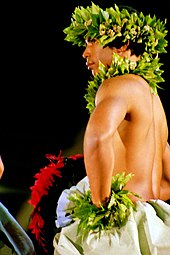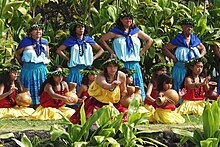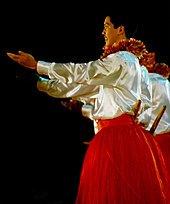Hula (dance)
Hula is a narrative dance that developed in Hawaii . The Hawaii archipelago forms the northern tip of the Polynesian triangle and is the 50th state in the United States . Hula is related to the dance forms of other Polynesian peoples, but has experienced an independent development because of the great distance between Hawaii and the other Polynesian islands.
style
Certain step figures follow the beat of the music or the (spoken) song, a story is told with other parts of the body. The narrative character of the hula enables it to be used for various purposes: as a cult dance, to preserve traditions (e.g. genealogies , myths , legends ), in various social contexts (e.g. family, nobility) or simply for Entertainment.
The meaning of the hula for Hawaiian culture is best expressed in a word from King David Kalākaua : "Hula is the language of the heart and therefore the heartbeat of the Hawaiian people" ("Hula is the language of the heart and therefore the heartbeat." of the Hawaiian people ").
Traditionally, hula in the Hawaiian language is learned in a hālau (school, originally: large house, hall) under the guidance of the kumu hula . The teacher's designation as kumu (source, origin) shows the high esteem and responsibility of those who pass on the knowledge.
The different types of hula can be classified according to the content of the song ( mele ), the accompanying instruments or the dance style. Now mostly be simplistic hula kahiko (ancient dances) and hula'auana (modern dance) distinction. This distinction is more related to the dance style. The Hawaiian word ʻauana means “to move forward, to move away”, in the sense of “to stray from the [old] way”, so that strictly speaking everything beyond the ritualized traditional hula kapu (the word kapu stands for the regulation) is hula ʻauana . At the hula kāʻekeʻeke , dancers are rhythmically accompanied with two bamboo stems ( kāʻekeʻeke ) .
Hawaiian dance began to change in the time of King Kalākaua , even if it was initially accompanied by chants and rhythm instruments. Many ʻauana - modern - dances are now more than 100 years old, and new kahiko- style dances are still being written.
Hulas, which are performed as a sitting dance , are called hula noho . The hula muʻumuʻu is also performed while sitting.
Hula kahiko
Preparation (e.g. learning and understanding the texts, making the jewelry), clothing and performance are particularly strictly regulated. Correct pronunciation is of great importance for the accompanying chant.
Instruments
- pahu : standing drum made from a hollowed-out tree trunk (mostly palm), traditionally covered with shark skin and originally reserved for ritual dances
- ipu: rhythm instrument made from a bottle gourd
- ipu heke: rhythm instrument made from two or three bottle gourds ( heke = highest, here: ipu with a top made from another calabash)
- pūniu: small kettle drum that is attached above the knee and whose body usually consists of a coconut ( niu )
- ʻUliʻuli: rattle from a tree calabash ( laʻamia ) or coconut with a handle, often decorated with feathers
- kalāʻau: wooden sticks in different sizes
- papa Hehi: the footboard with, kalā'au is used
- pūʻili: partially split bamboo sticks
- ʻIliʻili: stones abraded by the water, held in pairs in one hand and struck against each other like Spanish castanets.
Hula 'auana
In this style group, the hula has taken on a variety of influences, mainly from western musical styles. The elements of the dance are essentially the same, but are adapted to the changed accompaniment and the melodic singing. This is especially true of clothing, jewelry, and performance practice, which are significantly different from hula kahiko . This ability to change on the basis of unbroken tradition shows the vitality of the hula particularly clearly.
Instruments
history
Surname
The Hawaiian word hula was only used in connection with dances for entertainment until the mid-19th century, and only then was it extended to all dances. Before that the religious dances were called ha'a . The older name lives on in ʻai haʻa , a traditional style that is danced with bent knees.
Mythical beginnings
The goddess Laka first taught the inhabitants of Moloka'i to dance the hula. The place of the first hālau hula is still venerated today as Ka hula piko (origin of the hula). Hi'iaka , the sister of the volcano goddess Pele , is revered today as the patroness of the hula. She learned it from Hōpoe, who comes from Puna (on the island of Hawaii ), and who knew the dances of the ancients.
1820-1851
The abolition of the kapu system by Ka'ahumanu and the influence of Christian missionaries led to the ban on the hula from everyday life. In 1830 Kaʻahumanu banned hula in public, after her death (1832) the ban was no longer enforced in areas remote from Christian mission stations and pious chiefs.
After 1851
The ban on the hula was lifted in 1851, public performances had to be registered and were subject to high fees.
King David Kalākaua
Under King Kalākaua (r. 1874-1891) the restrictions were lifted. Furthermore, old traditions - if they still existed - were revived and especially promoted by the king. Large public hula performances were held at the coronation ceremony and the 50th birthday celebrations of Kalākaua.
1898 until today
After the annexation of Hawaii in 1898, hula was pushed back among other areas of Hawaiian culture under the influence of the USA. Around 1970 the Hawaiian renaissance began, which has continued to this day and also led to a growing return to the traditions of the hula. The clearest signs include numerous competitions and festivals, including the Merrie Monarch Festival (since 1963) organized in honor of David Kalākaua .
The use of "hula" in the name of the hula hoop is based solely on its resemblance to a single (ʻami) of more than 30 different hula steps.
literature
- Nathaniel B. Emerson: Unwritten Literature of Hawaii. The Sacred Songs of the Hula . Smithsonian Institution, Washington, DC 1909 (Bulletin of the Bureau of American Ethnology, 38)
- Dorothy B. Barrère, Mary Kawena Pukui, Marion Kelly: Hula, Historical Perspectives . Bernice Pauahi Bishop Museum, Honolulu 1980 (Pacific Anthropological Records, 30)
- Amy Kuʻuleialoha Stillman: Sacred Hula. The Historical Hula Ala'apapa . Bishop Museum, Honolulu 1998 (Bulletin in Anthropology, 8), ISBN 0930897730
- Winona Desha [Nona] Beamer: Nā mele hula. A collection of Hawaiian hula chants . Institute for Polynesian Studies. Brigham Young University. Hawaii Campus, Honolulu 1987, ISBN 0939154420
- Gabriele Hartinger-Irek, Roland Irek (ed.): Fairy tales from Hawaii . Diederichs, Munich 1997 (The fairy tales of world literature), ISBN 3-424-01365-X
- Ishmael W. Stagner: Kumu hula: roots and branches . Island Heritage Pub., Honolulu 2011, ISBN 9781597006217
Web links
- Search for Hula, Hawaii in the SPK digital portal of the Prussian Cultural Heritage Foundation
- Hawaiian Music and Hula Archives (texts and information about Hula in English)
- Emerson, Sacred Songs Of The Hula (online version)
- Philippa Pollenz: Changes in the Form and Function of Hawaiian Hulas. American Anthropologist, 52, 1950, pp. 225-234
- List of publications A. Stillmann with further literature ( Memento of February 4, 2012 in the Internet Archive ) (English)
- American Aloha - Hula Beyond Hawai ʻi (extensive material accompanying the film documentary of the same name)
- Hula groups in Germany ( Worldwide Hālau Hula , Engl.)
- No Ka Hoʻomanaʻo Ana Ia Berlin eV (Hula Association in Berlin)
Individual evidence
- ↑ hālau in Hawaiian Dictionaries
- ↑ kumu in Hawaiian Dictionaries
- ↑ hula noho in Hawaiian Dictionaries
- ↑ muʻuʻmuʻu in Hawaiian Dictionaries
- ↑ meant here is in English chant called Chanting
- ↑ hula in Hawaiian Dictionaries
- ^ Dance in Hawaiian Dictionaries
- ↑ cf. haʻa in Hawaiian Dictionaries , ʻai haʻa in Hawaiian Dictionaries
- ^ Missionaries and the Decline of Hula , HawaiiHistory.org; also: Hong, Cesily, " The Power of the Hula: A Performance Text for Appropriating Identity Among First Hawaiian Youth " (2013). Doctoral dissertations. Paper 56, p. 21: Queen Ka'ahumanu, the favorite wife of Kamehameha I and an acting Regent during the reign of Kamehameha II and Kamehameha III became a practicing Christian, and banned the hula and accompanying mele from all public venues.
- ↑ Chelsey Parrott-Sheffer: Hula Hoop . In: Encyclopædia Britannica , September 18, 2013
- ↑ cf. Kalani N. Poʻomaiahealani: Nā Keʻehi I Ka Haʻa - Hula Steps ; there is 'ami as hip rotation (rotation of hips) described




